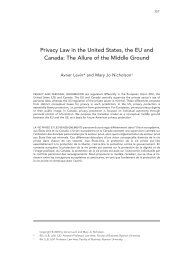Commentary on Fichte's “The Illegality of the Unauthorised ... - uoltj
Commentary on Fichte's “The Illegality of the Unauthorised ... - uoltj
Commentary on Fichte's “The Illegality of the Unauthorised ... - uoltj
You also want an ePaper? Increase the reach of your titles
YUMPU automatically turns print PDFs into web optimized ePapers that Google loves.
164 university <strong>of</strong> ottawa law & technology journal www.<strong>uoltj</strong>.ca<br />
introduces distincti<strong>on</strong>s into what is present as a unity within ordinary c<strong>on</strong>sciousness<br />
and <strong>the</strong>reby dissolves this whole into its comp<strong>on</strong>ents. 98<br />
According to Fichte, Kant had a passive understanding <strong>of</strong> percepti<strong>on</strong>.<br />
For Kant, percepti<strong>on</strong> is <strong>the</strong> result <strong>of</strong> “things in <strong>the</strong>mselves” that are ultimately<br />
unknowable acting <strong>on</strong> our sensory apparatus. However, Fichte held a different<br />
view. For him, <strong>the</strong> object, <strong>the</strong> “not-I,” limits <strong>the</strong> activity <strong>of</strong> <strong>the</strong> I. The “I” <strong>on</strong>ly<br />
perceives itself as an intellectual intuiti<strong>on</strong> that is part <strong>of</strong> every sensible intuiti<strong>on</strong>.<br />
As a result, Fichte does not posit a Kantian “thing in itself,” since it is from within<br />
<strong>the</strong> experience <strong>of</strong> <strong>the</strong> “I” that <strong>the</strong> “I” comes to understand <strong>the</strong> necessity <strong>of</strong><br />
something o<strong>the</strong>r than it. As Fichte explains in <strong>the</strong> Foundati<strong>on</strong>s <strong>of</strong> <strong>the</strong> Entire Science<br />
<strong>of</strong> Knowledge, <strong>the</strong> existence <strong>of</strong> external things is corroborated, not through <strong>the</strong><br />
fact <strong>of</strong> passive receptivity <strong>of</strong> sensory percepti<strong>on</strong>s caused by it, but ra<strong>the</strong>r through<br />
a limitati<strong>on</strong> <strong>of</strong> <strong>the</strong> self, “some check <strong>on</strong> <strong>the</strong> self.” The “impossibility <strong>of</strong> fur<strong>the</strong>r<br />
extensi<strong>on</strong> [<strong>of</strong> <strong>the</strong> self] would [. . .] delimit [. . .]; it would not set bounds to <strong>the</strong><br />
activity <strong>of</strong> <strong>the</strong> self; but would give [<strong>the</strong> self] <strong>the</strong> task <strong>of</strong> setting bounds to itself.” 99<br />
How does this help us to understand Fichte’s view that ideas are unique?<br />
Knowledge is created through <strong>the</strong> interplay <strong>of</strong> <strong>the</strong> self and <strong>the</strong> limitati<strong>on</strong> <strong>on</strong> <strong>the</strong><br />
self represented by <strong>the</strong> not-self (i.e. <strong>the</strong> object). These are unified through our<br />
imaginati<strong>on</strong>. This process <strong>of</strong> unificati<strong>on</strong> is unique to each individual because it<br />
is a c<strong>on</strong>stant process <strong>of</strong> unificati<strong>on</strong> with <strong>the</strong> unique imprint <strong>of</strong> each pers<strong>on</strong>. This<br />
is <strong>the</strong> origin <strong>of</strong> <strong>the</strong> uniqueness <strong>of</strong> an individual’s ideas. To follow this argument,<br />
we must understand that for Fichte, knowledge is <strong>the</strong> result <strong>of</strong> a syn<strong>the</strong>sis <strong>of</strong> <strong>the</strong><br />
activity <strong>of</strong> <strong>the</strong> “I” and <strong>of</strong> <strong>the</strong> “not-I”. This syn<strong>the</strong>sis is brought about through our<br />
imaginati<strong>on</strong>. 100 The power <strong>of</strong> <strong>the</strong> imaginati<strong>on</strong> is to unite <strong>the</strong> infinity <strong>of</strong> <strong>the</strong> self<br />
with <strong>the</strong> finitude <strong>of</strong> <strong>the</strong> object, which limits <strong>the</strong> power <strong>of</strong> <strong>the</strong> self to act. Fichte<br />
describes this interplay as follows:<br />
This interplay <strong>of</strong> <strong>the</strong> self, in and with itself, whereby it posits itself at <strong>on</strong>ce as finite<br />
and infinite—an interplay that c<strong>on</strong>sists, as it were, in self-c<strong>on</strong>flict, and is selfreproducing,<br />
in that <strong>the</strong> self endeavors to unite <strong>the</strong> irrec<strong>on</strong>cilable, now attempting<br />
to receive <strong>the</strong> infinite in <strong>the</strong> form <strong>of</strong> <strong>the</strong> finite, now, baffled, positing it again<br />
outside <strong>the</strong> latter, and in that very moment seeking <strong>on</strong>ce more to entertain it<br />
under <strong>the</strong> form <strong>of</strong> finitude—this is <strong>the</strong> power <strong>of</strong> imaginati<strong>on</strong>. 101<br />
The imaginati<strong>on</strong> is c<strong>on</strong>stantly syn<strong>the</strong>sizing <strong>the</strong> “I” and <strong>the</strong> “not-I.” In Fichte’s view,<br />
<strong>the</strong> boundary between <strong>the</strong> “I” and <strong>the</strong> “not-I” is never fixed and is c<strong>on</strong>stantly<br />
changing. For if <strong>the</strong> boundary did not shift, <strong>the</strong> “I” would completely determine<br />
<strong>the</strong> totality (i.e. <strong>the</strong> syn<strong>the</strong>sis <strong>of</strong> <strong>the</strong> subject and object), and so <strong>the</strong> passivity <strong>of</strong><br />
<strong>the</strong> “I” in encountering <strong>the</strong> “not-I” as limit would be completely illusory, and<br />
<strong>the</strong> “I” would be <strong>the</strong> complete ground <strong>of</strong> all percepti<strong>on</strong>. As a result, <strong>the</strong> limit<br />
<strong>on</strong> <strong>the</strong> “I” represented by <strong>the</strong> “not-I” is a real limit, and so <strong>the</strong> syn<strong>the</strong>sis <strong>of</strong> <strong>the</strong><br />
98. Fichte, “Sec<strong>on</strong>d Introducti<strong>on</strong> to <strong>the</strong> Wissenschaftslehre,” supra note 97 at pp. 48–49.<br />
99. Johann Gottlieb Fichte, “Foundati<strong>on</strong>s <strong>of</strong> <strong>the</strong> Entire Science <strong>of</strong> Knowledge,” in Peter Heath and John Lachs,<br />
eds. and trans., Fichte: Science <strong>of</strong> Knowledge (Wissenschaftslehre) with <strong>the</strong> First and Sec<strong>on</strong>d Introducti<strong>on</strong>s<br />
(Applet<strong>on</strong>-Century-Cr<strong>of</strong>ts, 1970) 89–287 at p. 189. First published in 1794 as Grundlage der gesamten<br />
Wissenschaftslehre.<br />
100. Fichte, Foundati<strong>on</strong>s <strong>of</strong> <strong>the</strong> Entire Science <strong>of</strong> Knowledge, supra note 99 at p. 193.<br />
101. Fichte, Foundati<strong>on</strong>s <strong>of</strong> <strong>the</strong> Entire Science <strong>of</strong> Knowledge, supra note 99 at p. 193.









